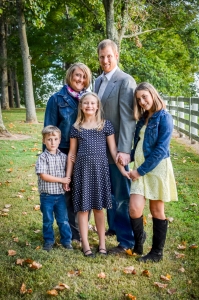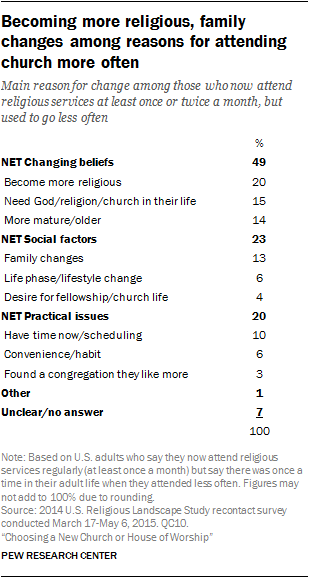This past week the Pew Research Center on Religion & Public Life released their newest findings on how and why people choose a new house of worship. It is a long report but I highly recommend reading the whole thing if you are someone that is interested in overall ministry within the church.
For those of us who are more specified in our interest, namely children, youth and family, here’s what I would call the Highlight Reel – the information most pertinent to these specific ministries.
1. 65% of young parents rank ministry to kids as playing an important role in choosing a new house of worship
Overall, 56% of adults who have looked for a new congregation say the quality of educational programs available for children was an important factor in their decision. Among those who currently are parents of minor children, however, about two-thirds (65%) say this. – Page 1, Pew Report
What does this mean for us?
It means that what we do matters to families that come and visit our church. In fact, this factor ranked 5th overall in importance, which is impressive considering this survey included those without children and those with grown children as well as parents of school-aged children.
2. The biggest reason to look for a new church (34%) is because of a geographical move not because of problems with their old church (7%).
About half of Americans have never looked for a new house of worship, perhaps because they are not churchgoers or because they have been members of the same church, synagogue or mosque since childhood…They are also more likely to have lived in the same place all their life. – Page 1, Pew Report
What does this mean for us?
It means that for at least half of the children you begin ministering to at birth will remain with you into adulthood. This is why generational discipleship is SO important. Helping those children and youth establish relationships within the church with people of multiple generations is essential to creating a strong ethic of mentorship and discipleship within the church.
3. The idea of “regular attendance” is a fluid one with most churchgoers BUT many say they attend church MORE now than that have in the past
More than a quarter of Americans (27%) say they currently attend religious services at least once or twice a month, but that there was once a time in their adult lives when they attended less regularly than they do now. And more than one-in-five adults (22%) say they currently attend religious services infrequently or never (a few times a year, at most), but that there was once a time when they attended more often. – Page 3, Pew Report
Perhaps this surprised you as much as it did me. We are always told that church attendance is declining in America so I was shocked to find that most evangelicals would say that they attend more frequently now than they did in the past.
That being said, the idea of attendance is quite fluid because the definition of attending regularly (in this study) is “once or twice a month.” You read that right. Once or twice a month is now considered regular attendance. That means, for the most part, you will get to interact with those families and kids for 1 to 2 hours a month. That alone shows the importance of reaching families in their home, workplace, schools, and athletic events with support and consistent communication outside the “box” of church. Our time with is important, but it simply doesn’t carry the most weight. The other 167 hours of the week are hugely influential and we need to be there.
4. Roughly 8 in 10 of religious “Nones” or the Unaffiliated were raised with a religious affiliation
There are clear patterns in the reasons “nones” give for disaffiliating, based on how they describe their current religious identity. For example, most of those who now identify as atheists (82%) say a lack of belief spurred them to become unaffiliated. By contrast, fewer than half of respondents who describe their religion as “nothing in particular” (37%) cite lack of belief as the reason they no longer affiliate with a religion. – Page 3, Pew Report
What does that mean for us?
If you are like me, your heart just broke a little. Maybe a lot. This is my why. This is what motivates me every day as I recognize that 80% of those who self-identify as “unaffiliated” were at one time part of a church or community of faith. And, a deeper study will show you, these are primarily coming from evangelical Protestant backgrounds. For more thoughts on this and on what we can do to turn this tide, please read this article regarding last year’s study released on the “Religious Nones” and this response regarding Millennials walking away from faith.
There is a lot more to be gleaned from the research provided by Pew regarding this topic but I hope what was highlighted will help us prayerfully consider who we can use the resources of time and community to help our children, youth, and families grow together as a community of faith.
Creating space for deep and meaningful intergeneration connections that extend beyond the walls of the church and the hour or two a month we might be there together is absolutely critical to helping our young people find their place of belonging within the congregation.
For more information regarding the current landscape of the church in America, please refer to the following information provided by Pew Research.
The first report on the 2014 Landscape Study, based on a telephone survey of more than 35,000 adults, examined the changing religious composition of the U.S. public and documented the fluidity of religion in the U.S., where roughly one-third of adults now have a religious identity different from the one in which they were raised. The second report described the religious beliefs, practices and experiences of Americans, as well the social and political views of different religious groups. A third report drew on both the national telephone survey and a supplemental survey of participants in Pew Research Center’s American Trends Panel to describe how Americans live out theirreligion in their everyday lives.
For more information about
- Kids in Worship
- Determining which Type of Family Ministry model works best for your church
- Discipleship in Intergenerational community
- Encouraging the continued conversation through Practical Discipleship at Home
- Seminars, Workshops, Coaching
Check out to ReFocus Ministry or “like” our Facebook page. Join our conversation at theReFocus Family and Intergen Ministry group on Facebook.
About the author
 Christina Embree is wife to Pastor Luke, mom to three wonderful kids, and family minister at Nicholasville UMC. She is passionate about seeing churches partnering with families to encourage faith formation at home and equipping parents to disciple their kids in the faith. Currently studying Family, Youth and Children’s Ministry at Wesley Seminary, she also blogs at www.refocusministry.org and is a contributing blogger at D6 Family, Seedbed, and ChildrensMinistryBlog.com
Christina Embree is wife to Pastor Luke, mom to three wonderful kids, and family minister at Nicholasville UMC. She is passionate about seeing churches partnering with families to encourage faith formation at home and equipping parents to disciple their kids in the faith. Currently studying Family, Youth and Children’s Ministry at Wesley Seminary, she also blogs at www.refocusministry.org and is a contributing blogger at D6 Family, Seedbed, and ChildrensMinistryBlog.com




1 Comment